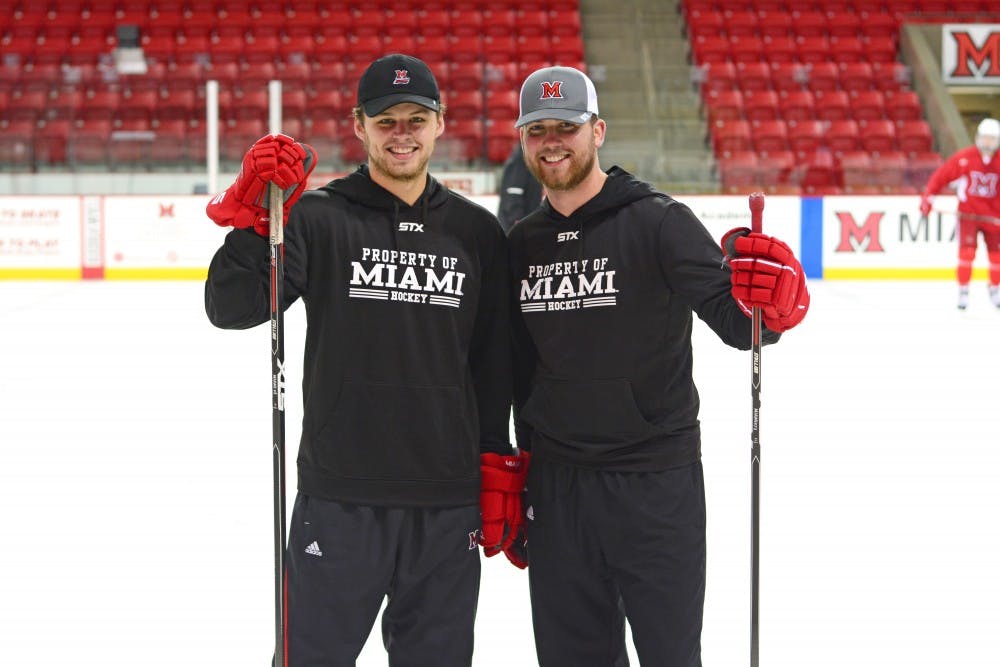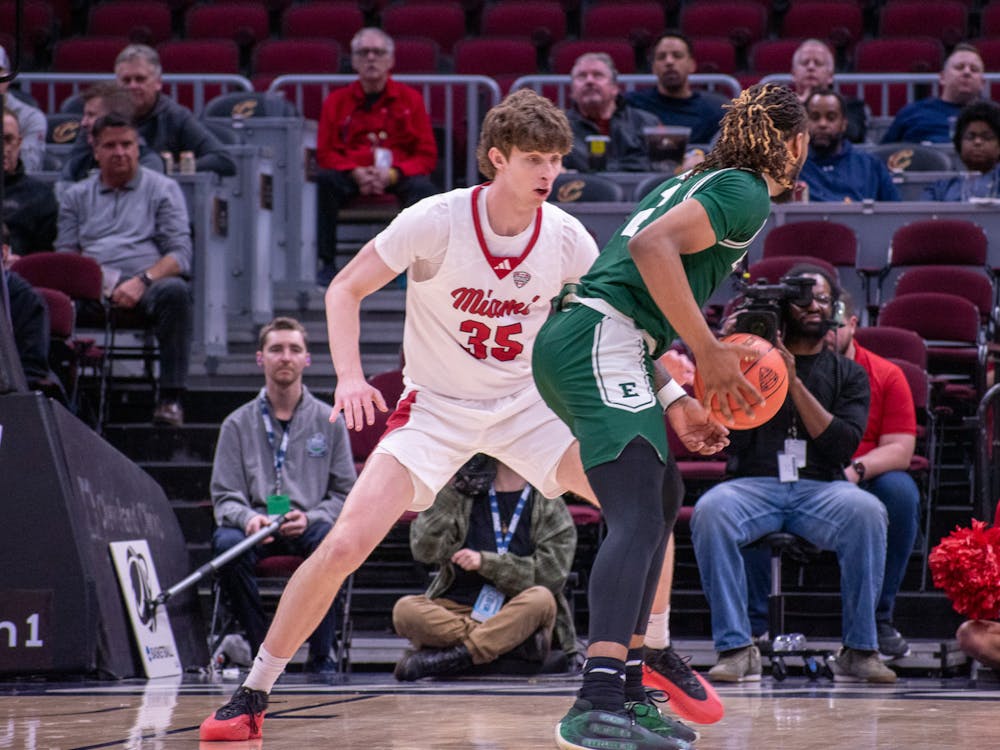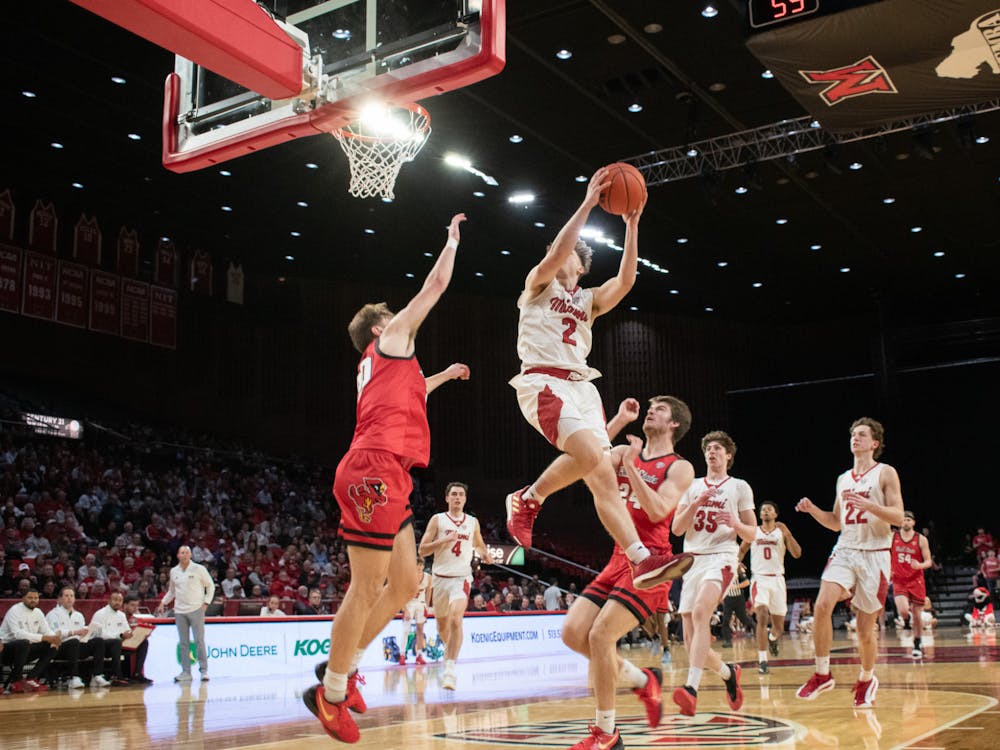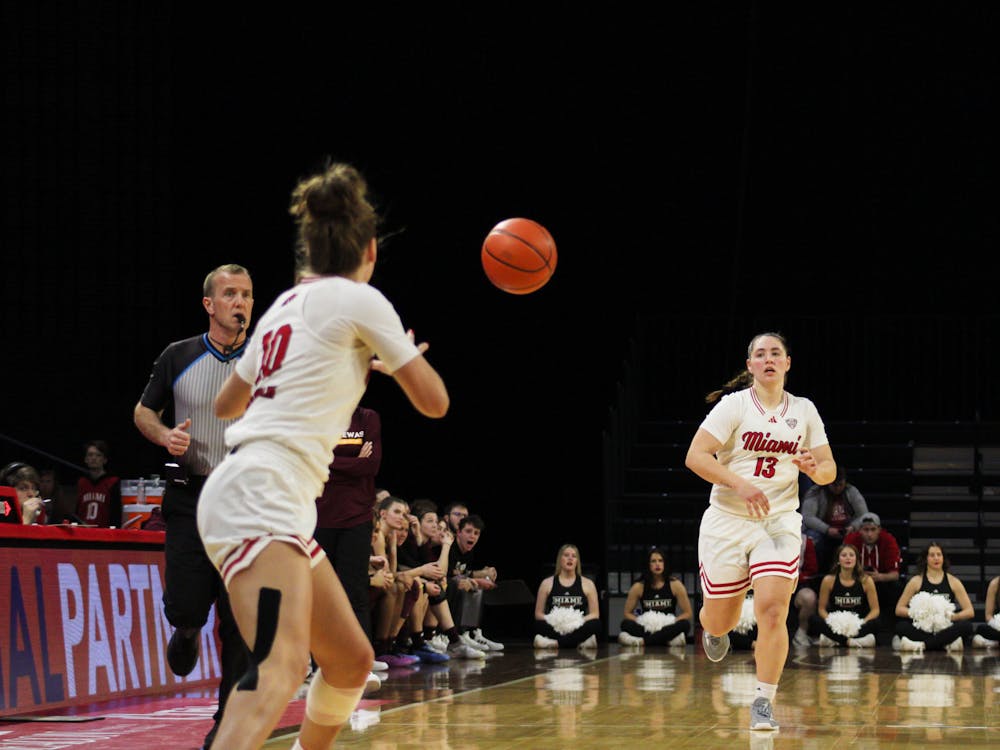The first Saturday in October started like any other game day for Miami University hockey's Bryce Hatten and Chase Munroe. They walked through the loading-dock doors on the side of the Goggin Ice Center, before buzzing into the locker room. They took the pregame skate and ate the pregame meal.
But a lot of things have changed.
For the first time in their hockey careers, Hatten and Munroe weren't listed on their hockey team's roster. They had decided to spare their bodies the pain that came with playing.
Thirty-eight minutes before puck-drop, they took the elevator to the press box instead of taking the ice for warm-ups. Munroe sat on the left and Hatten on the right, next to Ben Eaves, the team's human wellness and performance coach.
"It was the first time, sitting up in the press box, watching my team play," Hatten said. "Obviously, you get healthy scratches in juniors and college, sometimes you just don't play games, but this is the first year that I know for a fact I'm not playing."
Just like the 27 other Miami players, Hatten and Munroe started playing hockey when they were children.
One of Munroe's family friends took him to the rink when he was four, and he fell in love with the game. When he was seven, he fell in love with goalie pads and thought it'd be "so cool" to wear them.
He wore them for the Wichita Falls Wildcats, Fairbanks Ice Dogs, Michigan Warriors and Minnesota Wilderness during his junior hockey career before strapping on pads and pulling on a goalie mask with the Miami "M" to begin his collegiate career.
Hatten, now 21, started playing when he was four, as well. His family moved from Philadelphia to South Bend, Ind., and Hatten couldn't stop playing. When he was 13, he went to play in Michigan and became a defenseman because the forwards were too fast. He played in Michigan until he was 17 and went to play for the Cedar Rapids RoughRiders before arriving in Oxford.
Deciding to come to Miami had been an easy decision for both of them - its winning history, the coaches and the culture drew them to the Steve 'Coach' Cady Arena. "The Brotherhood" kept them there.
"On and off the ice, there couldn't be a better group of guys to be around," Munroe, 23, said.
Hatten had been healthy for his entire career before the summer of the 2015-16 season. He was skating at Notre Dame, five minutes from his house, like any other summer afternoon. But as he opened up for a one-timer, he caught a bad edge and felt a pop in his hip.
Enjoy what you're reading?
Signup for our newsletter
Stretching and icing didn't make the mystery injury any better, and an MRI revealed a torn labrum. Hatten had surgery to repair the torn soft tissue that surrounds his hip socket. Then, he began a six-month rehab to get back to where he was.
"It was a big-time blow for me because I was feeling really good at the time. But," Hatten said, pausing for 30 seconds, "injuries happen."
Munroe's injury didn't happen all at once. His lower back and hips have given him the most trouble. Freshman year, he broke his foot and, last season, he battled a collarbone injury on top of the pain in his back and hips.
For two years with Miami hockey, Hatten and Munroe ignored the constant pain. They grew closer with their teammates who turned into roommates and best friends. Hatten played 11 games for the RedHawks, and Munroe took the ice for seven.
Hatten re-tore his labrum last year and couldn't imagine another surgery and six-month rehab. Munroe's lower back and hips were begging him to stop playing.
"Every day it hurt," Hatten said. "It still hurts."
In March, they couldn't ignore the pain. It had kept them from playing good hockey and kept them off the ice on game days. They both looked in the mirror, listened to their bodies and thought about their futures.
"Hockey's not going to be there for the rest of your life and I want to be able to walk and hold my kids in the future," Hatten said softly.
Exit meetings were scheduled for graduating seniors and players opting to leave Miami. Hatten and Munroe got in line, but they wanted to stay.
"Leaving this place would have been the dumbest thing I could have done," Munroe said.
So, they stayed.
Head coach Enrico Blasi offered them student assistant positions with the program and seats in the press box on game days. Hatten and Munroe set up drills during practice, jump in on the forecheck if the team needs an extra body, and they work one-on-one with any player who needs help with a certain skill.
"Not being able to play, it sucks," Hatten said. "But being able to find a spot in the team and still contribute to our success for this season is a special feeling. It just makes you feel wanted."
They walk through those loading-dock doors at 1 p.m. Monday through Thursday for practice and lace up their skates. Except, they've traded pads for black coach's pants and shin guards, red and white jerseys for black "Miami Hockey" sweatshirts and helmets for ball caps.
"The transition kind of hits you like a train," Hatten said. "You're not ready for it, you're really not. Even if you know it's coming, it's a hard transition."
The transition was made easier by The Brotherhood. Coaches sent them texts over the summer asking them how the transition was going. They had been there, they had hung up their skates before.
Hatten and Munroe's teammates haven't. They can't empathize with Hatten and Munroe, but they're just as supportive.
"They know it's not an easy transition. We've been playing hockey for 18 years or whatever it is, and having to give that up," Munroe said, trailing off. "But staying here was probably a great choice for me. They still love us and treat us the same way."
Teammates still make funny faces at Munroe during practice, and sophomore Ben Lown gives Hatten a "surfs up" hand gesture when he walks past him after practice.
Still being such good friends with "the boys," Hatten and Munroe know when one of them is having a good time and are privy to when they're not. After skating with the RedHawks for two years, they can read a player's body language and know who needs to be hyped up and who needs to talk.
They relate to their teammates in a way coaches can't. They can walk into the locker room and know what kind of music to play to get the team going.
"Whoever's not feeling it today, we're here to bring the energy and make them realize that they're in a good situation still, they're still playing," Hatten said. "Just be positive and be thankful for what you have."
Hatten and Munroe are thankful for what they have now - more free time, a new-found bond between the two of them and a different perspective about the game they love - even if it means wearing a suit and tie to games and not a no. 30 or no. 5 jersey.
So, on the first Saturday of October, Munroe sat on the left and watched the goalies while Hatten sat on the right and tracked power-play stats. They silently cheered for their teammates two stories above the ice.
But a lot of things haven't changed.
Even though they've learned more about spacing on the ice and the timing of the game while shadowing Miami's coaches, they still consider themselves players. To the guys, Munroe and Hatten are still "Munny" or "Goopy" and "Hatts." They still go to class with their teammates and beat each other at video games during their free time.
They still sing the Miami fight song after a series sweep. This time, when they're standing shoulder-to-shoulder around the Miami "M" on the locker room floor, they're in suits - arms around their teammates' sweaty jerseys, feeling like they're still part of The Brotherhood even though they can't take the ice.
"I'm just going to accept my role," Hatten said. "I had fun with it, still up there cheering. I'm still fired up to see the boys win two games. I go inside [the locker room] and jumping up and down, singing the song after a sweep. It's dynamite."




